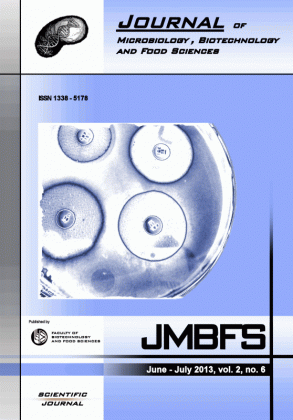SPATIAL VARIABILITY OF AIRBORNE BACTERIA IN THE MUNICIPAL SLAUGHTERHOUSE OF CONSTANTINE - ALGERIA
Keywords:
Airborne contamination, spatial distribution, slaughterhouse, North-East of AlgeriaAbstract
The spatial distribution of airborne bacterial contamination (with Total aerobic bacteria, Gram-negative bacteria, Coliforms, Staphylococci and Streptococci) was studied within the municipal abattoir of Constantine (North-East of Algeria).Open plate air samples were collected at twenty sampling locations weekly during two months. At the same chosen locations, temperature and humidity of the air were measured. The spatial distribution of bacterial contamination was studied using a Geographic Information System.
The viscera processing section recorded the highest bacterial concentration and poor correlations had been recorded between bacterial counts and the environmental conditions within the abattoir. The high air bacterial loads recorded all over the slaughterhouse were consequence of the execution of all processing operations within the same section (for both bovine and ovine carcasses) associated to the absence of structural barriers, spatial separation between processing operations and uncontrolled airflow.
This study highlights the poor hygienic level of the municipal slaughterhouse of Constantine. The implementation of serious measures is needed to reduce the risk of contamination and proliferation of pathogens in meat during slaughtering processes.
Downloads
Download data is not yet available.
Downloads
Published
2013-06-01
How to Cite
Agabou, A., Abdeldjalil, M.-C., Bensegueni, A., & Semouma, S. (2013). SPATIAL VARIABILITY OF AIRBORNE BACTERIA IN THE MUNICIPAL SLAUGHTERHOUSE OF CONSTANTINE - ALGERIA. Journal of Microbiology, Biotechnology and Food Sciences, 2(6), 2419–2422. Retrieved from https://office2.jmbfs.org/index.php/JMBFS/article/view/7096
Issue
Section
Microbiology
License
Copyright (c) 2013 Amir Agabou, Mouhamed-Cherif Abdeldjalil, Abderahmane Bensegueni, Soumia Semouma

This work is licensed under a Creative Commons Attribution 4.0 International License.
All papers published in the Journal of Microbiology, Biotechnology and Food Sciences are published under a CC-BY licence (CC-BY 4.0). Published materials can be shared (copy and redistribute the material in any medium or format) and adapted (remix, transform, and build upon the material for any purpose, even commercially) with specifying the author(s).

